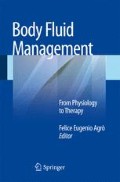Abstract
The human body is divided into two main compartments: intracellular space (ICS) and extracellular space (ECS). The ECS is divided into three additional compartments: intravascular space (IVS, plasma), interstitial space (ISS), and transcellular space (TCS) (Fig. 1.1). These compartments contain the body water and are surrounded by a semi-permeable membrane through which fluids pass from one space to another and which separates them.
Access this chapter
Tax calculation will be finalised at checkout
Purchases are for personal use only
Preview
Unable to display preview. Download preview PDF.
References
Chappell D, Jacob M, Hofmann-Kiefer K, Conzen P, Rehm M (2008) A rational approach to perioperative fluid management Anesthesiology 109:723–40
Miller RD (2009) Miller’s anesthesia, 7 edn. Churchill Livingstone, UK
Bernsen HJ, Prick MJ (1999) Improvement of central pontine myelinolysis as demonstrated by repeated magnetic resonance imaging in a patient without evidence of hyponatremia. Acta Neurol Belg 99:189–93
Kellum JA, Weber PAW (2009) Stewart’s textbook of acid-base, 2 edn. Lulu.Enterprises, UK
Kellum JA (2000) Determinants of blood pH in health and disease. Critical Care 4:6–14
Kellum JA (2005) Making strong ion difference the euro for bedside acid-base analysis. Intens Car and Emerg Medicine 14:675–685
Kellum JA (2005) Clinical review: Reunification of acid-base physiology. Critical Care 9:500–507
Astrup P, Jorgensen K, Siggaard-Andersen O (1960) Acid-base metabolism: new approach. Lancet 1:1035–1039
Siggaard-Andersen O (1962) The pH-log PCO2 blood acid-base nomogram revised. Scand J Clin Lab Invest 14:598–604
Grogono AW, Byles PH, Hawke W (1976) An in vivo representation of acid-base balance. Lancet 1:499–500
Severinghaus JW (1976) Acid-base balance nomogram—a Boston-Copenhagen détente. Anesthesiology 45:539–541
Siggaard-Andersen O (1974) The acid-base status of the blood, 4 edn. William and Wilkins, Baltimore
Siggaard-Andersen O (1977) The Van Slyke equation. Scand J Clin Lab Invest 146:15–20
Wooten EW (1999) Analytic claculation of physiological acid-base parameters in plasma. J ApplPhysiol 86:326–334
Brackett NC, Cohen JJ, Schwartz WB (1965) Carbon dioxide titration curve of normal man. N Engl J Med 272:6–12
Prys-Roberts C, Kelman GR, Nunn JF (1966) Determinants of the in vivo carbon dioxide titration curve in anesthetized man. Br J Anesth 38:500–550
Kellum JA, Kramer DJ, Pinsky MR (1995) Strong ion gap: a methodology for exploring unexplained anions. J Crit Care 10:51–55
Hendry EB (1961) Osmolarity of human serum and of chemical solutions of biological importance. Clin Chem 7:156–164
Olmstead EG, Roth DA (1957) The relationship of serum sodium to total serum osmolarity: a method of distinguishing hyponatremic states. Am J Med Sci 233:392–399
Glasser L, Sternglanz, PD, Combie J et al (1973) Serum osmolality and its applicability to drug overdose. Am J Clin Path 60:695–699
Voet D, Voet JG, Pratt CW (2001) Fundamentals of biochemistry. Wiley, New York
Mansoor MA, Sandmann BJ (2002) Applied physical pharmacy. McGraw-Hill Professional
Author information
Authors and Affiliations
Corresponding author
Editor information
Editors and Affiliations
Rights and permissions
Copyright information
© 2013 Springer-Verlag Italia
About this chapter
Cite this chapter
Agrò, F.E., Vennari, M. (2013). Physiology of Body Fluid Compartments and Body Fluid Movements. In: Agrò, F.E. (eds) Body Fluid Management. Springer, Milano. https://doi.org/10.1007/978-88-470-2661-2_1
Download citation
DOI: https://doi.org/10.1007/978-88-470-2661-2_1
Publisher Name: Springer, Milano
Print ISBN: 978-88-470-2660-5
Online ISBN: 978-88-470-2661-2
eBook Packages: MedicineMedicine (R0)

